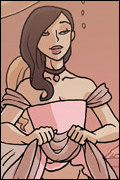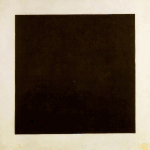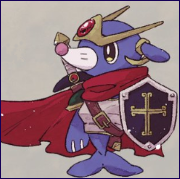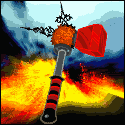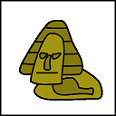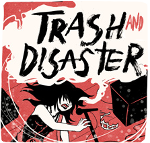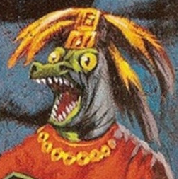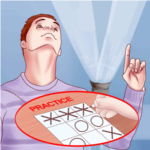|
Drunken Knights got its first playtest last week and it was a success! The tight hex map worked great, players had fun and no special power seemed overpowered. The rules are currently as follows: Set-Up • Every player begins the game with 4 life points. • Place the figures on the board to their starting places. • Everybody gets an identical deck of action cards. • Place the Holy Grail in the middle of the board. • The player who was most recently drunk takes the first player token. • Every player randomly draws 6 cards from their deck of which they choose 2 to keep. The four cards not chosen are displayed openly to other players. • Everybody is dealt one special card face down. Sequence of play 1) Everybody draws their hand to a hand size of 6. If there are not enough cards in your personal draw pile, shuffle the discard pile and draw the remaining cards. 2) Choose 4 cards to be resolved. Place them face down in front of you. 3) Resolve cards from left to right in clockwise order starting from the first player. 4) Leave the 4 cards face up. They can't be accessed for the next turn. 5) Move the first player token clockwise. 6) The game ends after 8 rounds or after everybody else is eliminated. (9 rounds with 3 players) 7) Calculate Fame Points and determine the winner. Action Cards • Sword: Attack from your current position. The range of the attack is determined on the card. Currently there are two types of attacks: a horizontal sweep and a stab that attacks the three hexes straight ahead. • Shield: Block from your current position. The range of the block is determined on the card. • Dodge: Move one step back and avoid one damage. Lose Grail if carrying it. • Movement: Move your figure on the board according to the card. If another player is occupying a hex your figure would move into, push the other player in the direction you are moving. • Double: Double or modify the effect of the next played card. - Apply the movement twice. - Increase the range of the attack card. The new attack patterns are displayed on the cards. - Shield blocks damage from all directions. - Dodge twice if you are attacked twice. Special Cards • Magic Potion: Heal one life point. Player's life points cannot exceed four. • Magic Scroll: Change the order of another player's two action cards. • Magic Shield: Makes the player invulnerable for the duration of the card itself and the next card. • Magic Bolt: A powerful attack pattern. This is still in the works. - Special cards are discarded after use and they cannot be doubled. Holy Grail • Players pick up the Holy Grail by moving through the hex in which the Grail resides. • Players can steal the Grail by attacking or pushing the player holding the Grail. • When the player would lose the Grail, throw a scatter die. Place the grail in the hex determined by the die result. Angry Crowd • Whenever a player enters the outmost hexes, take one damage. • Player is always pushed out of the crowd at the end of the turn. If there are two possible hexes, choose the one to which the character is facing. Fame Points • Succesful Attack = 2 FP • Killing Blow = 3 FP • Succesful Block = 1 FP • Champion of the Holy Grail = 1 FP / Turn • Survivor = 1 FP / eliminated player at the end of the game (e.g. two players were killed so the two remaining players receive 2 FP each) The only problem currently is the fact that even though the hex map is small, it is still easy to get too far away from the other players. One player suggested introducing some new special hexes with hindering effects so that it is harder to navigate the board succesfully. For example, stepping on a hex slippery with beer would force you to play one card less on your next turn. Other possibility would be to design special hexes BUT not make them permanent and static and rather roll a die to place them on the board after each round and draw them from a bag. The effects should be minor annoyances like chancing the direction of your facing, randomly losing a card from your hand etc. I'm quite hopeful I've stumbled into something light but fun with my design. Can't wait to playtest this more. 
These Loving Eyes fucked around with this message at 19:04 on Feb 11, 2014 |
|
|
|

|
| # ? May 14, 2024 11:39 |
|
I think it sounds pretty cool. I'd try adding a couple tables and chairs semi-randomly sprinkled around (can be broken by attacks for minor fame points, obstructs movement in some way, maybe acts as a shield if grabbed?)
|
|
|
|
I was just looking through some old files and came across the rules I wrote for a game I made. I went through and retouched some awkward wording but wanted your folk's opinions. Here it is.
|
|
|
|
xelada posted:I was just looking through some old files and came across the rules I wrote for a game I made. I went through and retouched some awkward wording but wanted your folk's opinions.
|
|
|
|
The Leper Colon V posted:You jump right into rules without giving us any idea of the flavor or tone. So, the reader has no reference point, no way to know the proper frame of mind. The idea is for it to be generally usable, in fact its name, GUST, stands for Generally Usable Strategy Tech (like GURPS but for strategy/wargaming).
|
|
|
|
Update on Monster Hunter: Haven't gotten a chance to playtest with friends using an aggro system, since something came up and we didn't have time for another game. Currently playing around with ideas for a card-based combat system, though. Right now I'm not happy with dice being used for combat, as it just isn't providing a lot of meaningful choices to players during the game. My current idea is to have a combo-based card system for attacking. Each card would represent a specific attack, and would have a symbol on it, an effect, and then more symbols on the side showing what the card could be combo'd into. You can only play one combo per turn, so the idea would be to try to chain together as many cards as you can at once. So say I play a Gunlance Upward Thrust card that has a I'm still working out the details, but I think that general system could work. The problems I have with it right now are: 1) How to tie stamina and evading into the system. I'm thinking each card could have a stamina cost, but then how would evading work? An idea I've got now is to remove stamina entirely, and instead have the cards themselves represent your stamina. Each card would have a value, and each monster attack would require a specific value of cards be discarded in order to evade it successfully. So you could discard your Greatsword Level 3 Charge card to really easily evade a big monster attack, but then lose out on that damage. However, that would lead to players burning through cards kinda quickly, which leads to my next problem.. 2) How should the deck creation work? Should there be a deck for each specific weapon, and players choose one at the start? Should each player have their own custom-made deck? Should there be one giant deck that all players draw from and then they can share cards with one another? Should it be some kind of deck building game? Should the cards JUST be attacks, or should I work items into cards as well? While writing this up, I've actually come up with an idea that MAY work, but I'm not really sure yet. Before the game starts, each player chooses a weapon deck that only provides attacks. Then players draft item cards into their decks from a central pool of cards, similar to a deck building game. Once X round of drafting has passed, then drafting ends and players have to play with the decks they've built. Although this would mean it's a deckbuilding game where players aren't building their decks over the course of the game itself, which means players don't get the satisfaction of watching their horrible machine grow aside from being able to 'gather' more cards while on the field. 3) Players are on a team together so there's no reason to hide information from one another. This is just kind of a minor problem I guess, but is still a problem. I've worked out some rules for a 5-player variant where a player takes control of the monster itself - in this situation, it would be worthwhile for hunters to hide that information from the monster, but there still isn't any real reason to hide that information from other hunters. I've vaguely considered a coopetition-style system where hunters can carve monster parts off of the monster during fights by breaking parts to earn victory points, and then whichever player has the most at the end wins. Breaking a part would earn you X number of VP, and then when the monster dies each player gets some as well. My initial thought would be players grab tokens with varying amounts of VP on them to keep with the "dunno what I'm gunna carve off next" feel, but that would likely end up being far too random. Furthermore, that idea in general kinda turns the game into one long round of Cuthroat Caverns so I'm not fully sold on the idea yet. 4) This idea in general would likely lead to CARD OVERLOAD which I know isn't really that great from a design perspective. All that said, I've also never design a card game (despite the fact that I love playing them) so I'm not super confident in my ability to do so. Any thoughts on some of these issues and this idea as a whole would be greatly appreciated.
|
|
|
|
How about players choosing their few pieces of equipment at the start, each providing a little predefined set of cards? Like, light armor providing more dodge cards and heavy armor more block cards or whatever. Or, if you limit yourself to just attack cards, players could "craft" their weapons from litle component sets, like Magical + Obsidian + Halberd. So you've got a chance to customize (or get meaningful loot from defeated monsters!), but don't get into the full-on deckbuilding sperg territory.
|
|
|
|
So, I've got a game-publishing question. My 'wizard school sim' game is shaping up nicely, the mechanics hold together to sanity tests, and I've yet to find any glaring flaws. Which means I'll start putting it out for playtesting soon(ish). And that got me thinking about print-and-play. Specifically, if I release as print-and-play, what that will do towards either building popularity, or shooting myself in the foot for publishing. The OP implies that different publishers have different opinions on things. Is there a more detailed list of the who's-who in indie board game publishers, what kinds of genres they look for, things to know about their application process, etc? girl dick energy fucked around with this message at 05:07 on Feb 16, 2014 |
|
|
|
I played One Night Ultimate Werewolf the other day; It was a lot of fun, and made me think about traitor games again. Specifically, the very start of them and what I perceive as a problem waiting to be fixed. In both Resistance and ONUW players have basically zero information to go on, barring a few scattered roles knowing bits and pieces - Merlin knows who is bad (but not what they are), the Seer knows concretely what one other player is or two things no one is, Percival knows who Merlin is, etc. The rub being, no one knows where to start. In ONUW's case, my group sorta awkwardly stood there for a second before either one player said "I'm the X" or asked "Ok, who is the X", and it all just felt sort of arbitrary and unguided. Reading someone's writeup for Two Rooms and a Boom in the main board game thread makes me think this might be an issue there too, where the game just assumes someone will be a loudmouth and tell the first lie to get things going (which, to be fair, isn't unlikely, but it's a party game and a lot of people I've played party games with don't really "get" why or when you'd lie or why you'd believe someone initially). Resistance is a bit better due to its structure, but the first round feels like a complete waste and often doesn't really offer any real information (unless someone fails it, which isn't terribly often in a <8 player game) - You're just picking people arbitrarily if you're a Knight, and if you're evil you probably are just putting yourself and another bad guy if you can sway it on the mission to maybe-sorta give you something to point at later and say "hey, we passed this, we're good!" (but everyone knows that so it generally only works against new players). My issue isn't with the strategies though, but the lack of having anything concrete to go on for many of the people at the table for the first few minutes of a game. I feel like there should be something known, maybe a character or two who isn't hidden but doesn't need to operate from the shadows to accomplish whatever their win condition is, be it an individual one or one to help a team. Maybe there already is a game like this, but I never hear anyone talking about it if so. Has anyone else experienced this and thought it was an issue? Obviously people who have 50+ games of Resistance under their belt can have crazy weird first round metas if they're playing with their friends, but I regularly play with people who have 0-3 games played, and so it isn't uncommon for me to hear "so uh, what do we DO?" in that first round/initial awkwardness.
|
|
|
|
Hmm. Blood Bound has each person look at the loyalty of the person to their right. (Of course, the Harlequin is the reverse alignment and the Inquisitor is evil no matter which side he claims to be, but anyway.) That helps a little bit, but in big games like Mafia/Werewolf, it wouldn't tell you much, especially since most people are Townies. But I agree. To me, the whole game almost seems pointless. "We have no one to lynch, so let's just go to the Night. Oh no! Someone died! Guess it wasn't him then." How do you ever decide who is Mafia other than baseless accusations or revealing you're a Cop? And Resistance is the same way, especially when the group I was in said, "Always pass the first mission." Well, what's the point of the first mission if it always passes, then?! EDIT: As to Two Rooms and a Boom, yeah, I agree with that. And possibly Coup as well. ActingPower fucked around with this message at 21:08 on Feb 16, 2014 |
|
|
|
CodfishCartographer posted:Lotsa words! I think you have plenty of design space to work with even if you completely remove Stamina from the game, so I'd try that approach. To keep Evading and Blocking as useful mechanics you could have turns run on a sort of initiative, with a round lasting as long as it takes a monster to perform it's actions. Say you've got a two player game where they are hunting a Great Jaggi. Your players are using Dual Swords and a Hammer. One turn while they're in combat the Jaggi turns towards the DS player and starts it's "Leap Back, Lurch Foward" combo. That combo takes six initiative phases (6I) all together, plus lets call it 2I to turn and look at the DS player, which makes this round last for 8I. The players then lock in their actions by playing cards. So at the start of the turn, the Initiative Track looks like this (o represents a single initiative tick) : pre:DS H o o o o o o o o o o J pre:DS
H o o o o o o o o o o
Jpre: DS
H o o o o o o o o o o
Jpre: DS
o o o o H o o o o o o
Jpre: DS
o o o o H o o o o o o
Jpre: DS
o o o o H o o o o o o
JThe H hunter is feeling pretty safe so he starts to Charge. We'll say Charging a Hammer just makes your movement take +1I, so he also elects to move slightly further away from the Jaggi for 2I. pre: DS
o o o o o o H o o o o
Jpre: DS
o o o o o o H o o o o
Jpre: DS
o o o o o o o o o o H
Jpre:DS o o H J If you think this gives the players too much room for maneuvering you could even have them lock in 2+ cards at once, meaning they'll be rewarded for already knowing how the monster attacks. Let me know if any of this looked helpful to you! If you don't end up using this I will probably find something to use a system like this!
|
|
|
|
Misandu posted:Let me know if any of this looked helpful to you! If you don't end up using this I will probably find something to use a system like this! This is actually a massive help, thanks a ton. I dunno why I never thought of an initiative system, especially since I only just started playing Galaxy Trucker recently  I may not wind up using this exact system, but it's definitely given me some food for thought. I really like using an initiative track to keep track of time in general, I'm just trying to visualize how it could all work physically. You'd need some kind of marker to ensure players know when cards they play will take effect, or how long those cards will take effect for - even in your simple example, you forgot that the Hammer user used his heavy smash - unless you were meaning that attacks take place immediately, then the initiative change is the delay of the attack. Also unsure of how to work monster combos with cards being drawn randomly - if it's a player controlling the monster that problem would be easily fixed, though. I may not wind up using this exact system, but it's definitely given me some food for thought. I really like using an initiative track to keep track of time in general, I'm just trying to visualize how it could all work physically. You'd need some kind of marker to ensure players know when cards they play will take effect, or how long those cards will take effect for - even in your simple example, you forgot that the Hammer user used his heavy smash - unless you were meaning that attacks take place immediately, then the initiative change is the delay of the attack. Also unsure of how to work monster combos with cards being drawn randomly - if it's a player controlling the monster that problem would be easily fixed, though.My initial idea would be to have everyone taking turns at the same time, with each card having a position on the track it needs to be placed. Each player can start one combo of attacks per round, but can dodge by playing a card for evading on the turn(s) that a monster is attacking (assuming that the player isn't attacking). Once all cards are placed onto the initiative track, it reads from left to right Space Alert-style as things happen. I was initially worried that this would give players too much foresight (as they could see what a monster will do), but then I had an idea that may be crazy but I dunno - the BACKS of the monster attack cards could list what initiative space the card would be placed on, so players would have a vague idea of what the monster will be doing, but not specifics Keeping with the Jaggi example (but swapping Hammer for Gun Lance), let's say the Jaggi's next card has a delay of 3 on the back, so it's placed onto the fourth tic (with players starting on tic 1), face-down. pre:GL
DS o o o o o o o o o
J
pre: GL
DS o o o o o o o o o
J
pre: GL
o DS DS o o o o o o o
J
pre: GL
o DS DS DS[E] o o o o o o
J
I think this system could probably help reduce some of the upkeep stuff of trying to remember what's taking place when, but maybe I'm just overcomplicating the system you lined out? e: Actually thinking it through more, I think your system might wind up being better overall, but I'll leave this up here for commentary. CodfishCartographer fucked around with this message at 23:39 on Feb 17, 2014 |
|
|
|
LoanWolf posted:So I've been working on my first game design... put together a functional prototype, designed and made up 104 different cards (12 of which I've already redesigned), and gone through one playtest. I'm impatiently waiting for the cubes I've ordered to arrive, and it takes forever to get a group together to run-through the game (I'll probably only get to once a week). The first playtest went fantastic. Everyone seemed to have fun and was really into it. The game ran longer than I'd like, so I made changes to shorten it (I'm hoping to be 45 mins to an hour with 5 players). Update on Ecologix: I've had 5 playtests now, usually with new players each time. Gamers and non-gamers have really taken to it... so far it's been very fun. My cubes have arrived and I got some custom cards made up at https://www.printerstudio.com that should be here in a couple weeks. Which by the way seems fantastic: 104 custom full colour cards (front and back), with rounded corners and glossy paper, with free shipping, for $12? Woah. Has anyone else used them? What's the quality like? I'm excited for them to show up. I never got any responses about my initial question about my rules, so I'll ask for some more specific advice on graphic design. Here is one of my player boards. Everyone is a species of microorganism (of a different colour), so I found some cool bacteria images of different colours and used them as the backgrounds:  Those are all well and good but I'm at a loss to how to represent my "swamps". They're fine for my early prototype, but I'd like to make them look cooler and more appealing. There's 5 of them - 5 locations in the game that players can move to. There's a black swamp, white swamp, gray swamp, brown swamp, and orange swamp. Each one needs a space for a deck of cards, a discard pile, an area to hold nutrients, an Acting Species area, a Conflicting Species area, and a Nutrient Spawn Rate Track. Right now they look like this:  Any ideas? Maybe making the swamps non-rectangular for starters. What kind of image or graphics might represent a swamp? Images that will also make it very clear what colour swamp you're in.
|
|
|
|
Yea in my example the hammer guy (I just got into MH3U and that's what I've been playing with haha) hits immediately on his attack, but you could always tweak the way effects fire. Let's say you have an attack, we'll call it Overhead Smash. It could cost 3I to perform, so you won't be able to act again for 3 ticks, but deals it's damage immediately. Then you could have another attack like Super Pounder that costs say 5I to use, but deals it's damage on -1I. So to use Super Pounder you would move ahead 4 ticks then put a Damage Marker on the space behind you on your track (every player would have their own track). This means you'd both have to make sure that the monster is still going to be in range for the attack to hit, AND means that you can launch an attack timed to hit when the monster moves into range. Using my Dual Swords example above, a combo would deal damage immediately then put a Damage Marker on every tick between where you are and where you were. You could even have special evasions that were playable in response to something but removed all of your damage markers on your track. Of course being interrupted while there are damage markers behind you would remove them as well. Actually yea this idea seems pretty solid, because it would give you a way to do things like the charged up bow shots. You charge up which costs some ticks, then firing costs like 2I and deals damage on +2I. You could simulate stuff like having to lead shots by making even the regular attacks hit on +1I. I was thinking about how you wanted to implement little monsters as well. What if having a little monster near you meant that periodically they had a chance to disrupt what you're doing. They could each have a die of negative things that they do and move and act at set points on the track. So like you could have Jaggi who roll a d4, on a 1 or 2 they just growl at you. On a 3 they do that little thing where they jump back away from you, and on a 4 they take a bite at you that pushes you forward a tick or two. Hell you could just make the monsters themselves represented by their dice! So Jaggis are swarms of little purple d4s.
|
|
|
|
Misandu posted:So Jaggis are swarms of little purple d4s. Oh my god this is loving brilliant. I like the idea about having attacks that have a delay on the damage itself, could then set up for various timings on attacks. Are you thinking it would work with the Galaxy-Trucker-style of initiative - whichever unit is in first goes first - or a Space-Alert-style of everything happens in one round, then goes onto another? Also, I'm debating with myself how I want to implement being within range of skills. Right now there isn't a board, instead focusing on just the hunters and the monster. I've got a few ideas on how it could work with a square/hex grid, but none that I'm really crazy about since there'd need to be a way to streamline the monster's AI (hence why I didn't have a board in the first place). I suppose if I make it always require a player controlling the monster it could work, but I'd like to keep some way for players to fight against an AI monster. poo poo, forcing it so that a player always controls the monster WOULD remove a lot of the headache of the design so far with aggro, attack randomness, etc.
|
|
|
|
quote:Let's say you have an attack, we'll call it Overhead Smash. It could cost 3I to perform, so you won't be able to act again for 3 ticks, but deals it's damage immediately. Time as a resource is crazy underused - I really like Glen More style timing, where there's essentially a circle of time and a "hand" that rotates around and determines who moves next. Big moves push you forward further chronologically, meaning you won't move for longer. In an interactive combat game it's even better, as you can plan moves to complete moves based on what you see coming up. quote:Also, I'm debating with myself how I want to implement being within range of skills. Right now there isn't a board, instead focusing on just the hunters and the monster. I've got a few ideas on how it could work with a square/hex grid, but none that I'm really crazy about since there'd need to be a way to streamline the monster's AI I'd think you could limit it to just "range" in a single line. This gives you freedom to put location based "stuff", while leaving the AI very approachable (I really like the stack of cards AI style, a'la Sentinels - but in a game with better mechanics).
|
|
|
|
So I had the weirdest idea jump into my brain. I've got the basic structure planned out, but I could use some help with expanding it and making it work. Here's the idea:Summary posted:The Square Isle is ruled over by four nations spread willy-nilly over the surface. As of recent, the rulers have gotten into petty border disputes, to the point where nobody's exactly sure who controls where. Desperate, the four rulers agree to hold a convention to determine the reach of each respective kingdom. Once they've gotten into the meeting hall, they realize none of them actually brought a map! Undeterred, they decide to begin the negotiations anyway. Which means, of course, that they're all going to lie about anything and everything they can until their pants catch on fire. Was Lord de la Rouge's city in the Amalouk Desert attacked by a horde of goblins from King Verde's forests in the south? Does Lord de la Rouge even have a city in the Amalouk Desert? Does the Amalouk Desert even exist? At this point, who has any idea? What's really important is the money and power. The truth is just whoever's loudest. So, as the summary says, the point of the game is for each ruler to claim that they have control over parts of the board representing different sections of the island. To do this, they play cards representing the places or things they want to pretend exist. Once a player has made a claim, the other players can piggyback off of it, lending credence to the idea that the claim is legitimate. Now, that's not saying it is at all. Another player might play a card in the same area and claim that they know what the island actually looks like. This is what I'd call a "Dispute." I'm still working out how to resolve Disputes, but one idea I really like involves sending out the Island Cartographer to go out and check. Who, naturally, you can bribe to say that it matches what you're claiming. Anyways, the cards build off of each other. I'm also working out the kinks here, but for example, if your territories have certain resources, you can use them to boost other claims. (So if you have so many trade points, you can claim a Trade Route, or if you have lots of Mountains, you can claim your cities got hit by a volcano, so you need extra money for disaster relief.) Eventually, you'll have this massive story concocted about your kingdom and what's happened in it, which will all come crashing down if Grand Poobah Blue dares to suggest that he's the one who controls Sector A2, and oh yeah, it's actually a forest, not a desert. I've also got this idea about having special Bureaucracy cards that let you do stuff inside the convention room, like calling on a tax for the country with the most trade points, or taking over a spot someone else is claiming. Again, broad strokes so far, but I think it has some promise. I can't help but laugh at the image of these nobles pretending that oh yeah, they totally know what their kingdom is like, and how dare anyone suggest otherwise! And two of the kings get into this huge argument about whether square C5 is a river running through a forest or a bustling port city by the mountains, only for the Cartographer to come back and reveal it's actually a desert. So... yeah, that's my idea. Points I want to iron out: 1) Do you think the idea is sound? 2) How big should the island be? I'm waffling between 5x5 and 7x7, but it could probably be bigger if necessary. 3) What Terrains do you think I should have? Right now, I'm going with Deserts, Mountains, Forests, and Coastlines (which are always on the edge of the map). More? Fewer? 4) How many resources should I have? Right now, I'm looking at 3: Trade, People, and Art. I have no idea if those make sense or if I should have more or fewer than that. Oh, and each card has a Victory Point score which'll be how you win in the end. 5) What do you think about the cards and the general system? Play Terrains, put Features and Events on them. Bicker amongst each other, play Taxes, Treaties, and Takeovers against each other. Then at the end, whoever can lay claim to the best kingdom (legitimate or not) wins! Hope that's enough information for starting the discussion.
|
|
|
|
CodfishCartographer posted:I like the idea about having attacks that have a delay on the damage itself, could then set up for various timings on attacks. Are you thinking it would work with the Galaxy-Trucker-style of initiative - whichever unit is in first goes first - or a Space-Alert-style of everything happens in one round, then goes onto another? Maybe just make it Tokaido style - the person furthest to the left on the initiative track (i.e. the person who has thusfar spent the least amount of time) always takes the next action. So if you play a bunch of small, unimportant actions, you can chain several in a row while the monster charges for its attack. To further streamline the delay-on-attacks and attack interruptions, maybe you play your action card down and move your initiative marker the appropriate number of steps. Then, when your next turn starts, the card in front of you resolves. So let's take our example, with Hammer, Bow, and Monster (I'm not actually familiar with the Monster Hunter games, so forgive me using generic fantasy words) quote:H . B . . . M . . . . . Hammer is farthest left, so it's her action. She plays Overhead Smash, which costs 6 initiative. She puts the card face-up in front of her, "charging" the attack. quote:. . B . . . M H . . . . Bow is furthest left. He charges Eat Herbs, to draw some cards or recover hit points or whatever. The Herbs cost 1 initiative. quote:. . . B . . M H . . . . Because all he did was jam some plants in his cake socket, Bow is still farthest left, and acts again. Herbs do their effect. He charges Take Aim, which costs 2 initiative and gives him a bonus to his next attack. quote:. . . . . B M H . . . . It's still Bow's action. Take Aim resolves, giving a bonus to the next card. Bow finally quits faffing about and charges Killing Shot, which costs 6 initiative. quote:. . . . . . M H . . . B Monster's turn. He draws an attack card, Tail Sweep, which costs 3 initiative, placing it next to the monster board. (Alternately, to preserve suspense, the cards could have initiatives printed on the back, and effects printed on the front, so you only know when the monster will act, not what he'll do. Of course, seasoned hunters will know the various things a monster can do on a four initiative card, and can plan accordingly.) quote:. . . . . . . H . M . B Hammer's turn. She finally lands her Overhead Smash, dealing six damage to the monster's right forepaw. She then charges Uppercut Smash, a 6 initiative attack. quote:. . . . . . . . . M . B . H The Monster attacks with its Tail Sweep, hitting the Bowman. The hit disrupts the Bowman's attack--forcing him to discard the card he was charging for no effect. Monster then draws a 2 initiative attack. quote:. . . . . . . . . . . B M H Bowman's turn. Because his Killing Shot was disrupted by the Tail Attack, Bowman resolves jack poo poo. He charges Hide In Tall Grass for 3 initiative to protect himself. (Perhaps Hide In Tall Grass has a protective effect while it's charged, rather than on resolution.) quote:. . . . . . . . . . . . M H B Monster turn. His 2 initiative attack resolves--a Terrifying Roar, which pushes both the Bowman and the Hammer four spaces further down the initiative track! Monster then conveniently draws another 3 initiative attack, which will now resolve before the Hammer gets her swing... And so on until someone dies or flees. You could also use this mechanic to streamline evades and blocks: If a Hunter and a Monster end up on the same initiative, the Hunter's attack is instead treated as an Evade/Block to reduce damage. I'd also just remove or abstract the range, since you've already got a positioning puzzle going on with the monster-board. Maybe an effect like Leap Back moves all Hunters into the monster's front arc. Possibly with an initiative penalty to the Hunter already in the front arc, since they're now out of position and need to run a bit to catch up. gutterdaughter fucked around with this message at 06:51 on Feb 18, 2014 |
|
|
|
You know, I think I like that system variant the best. It's fairly simple without having to worry about damage markers or anything and all players can be on the same track to make keeping track of things easier. The only issue so far is to how to have it loop together infinitely. Having two/three tracks, and just sliding them along to create a never-ending line would work, with maybe one of them having a marker line that signifies time passing, and once it's passed X times the hunters lose. A circular loop would also work, but then it kinda stops making sense when someone has delayed themselves SO MUCH that they pass the starting point and would go first. Right now the plan is to have the player decks be a pseudo deck-building game. Players will select a weapon deck that gives all attack cards, an armor deck that gives various defensive bonuses, and then four different item types. They shuffle all these cards together to create their own personal deck that they'll use in the game. Each monster will have its own deck of cards. I might wind up removing the armor deck to just have armor give passive buffs rather than being active cards, but I'll definitely keep weapon and item cards. It'll really depend on if I can come up with enough uses for armor cards to warrant their use. e: Also unsure of if I want to keep the symbol combo system or not. Obviously with some weapons like Dual Swords they'd be based more around combos, but I'm more concerned about how to implement them within this system. My current plan is to make it so the first card that starts the combo will determine how far it'll delay you, then you can play combo cards immediately after the starter. When it comes time for the starting card to resolve, you'll move your marker X time tics forward and then the next time you get a chance to resolve, you resolve the next card in the combo. So basically, you set up a large combo at once, then it resolves over time, and you can't place any more cards until the entire combo resolves. The theory being that overall it'd delay you less than one big attack would, but you can't change your plan once you've locked it in. In order to prevent the entire combo from firing off at once in quick succession, each new card in a combo will delay you exponentially further (so the first card after the start will delay you 1 tic, the 2nd will delay you 2 tics, etc) CodfishCartographer fucked around with this message at 19:22 on Feb 18, 2014 |
|
|
|
quote:A circular loop would also work, but then it kinda stops making sense when someone has delayed themselves SO MUCH that they pass the starting point and would go first. If you have, say, 12 segments on your time track, you just don't let anyone spend more than 12 time at once (and prevent any "time-bump" effects, if you have any, from pushing you any further out). Speaking of which, being able to move others on the time track (either to hasten or delay their actions) makes for a very interesting support sort of role. Anyway, the game is sounding good to me - I think it'll end up with some good tension and interesting decisions.
|
|
|
|
Eh y'know what, Galaxy Trucker just kinda glanced over this problem so I think I'm just overthinking this way too much. I'll just have a point be the start that will add a time counter if a player passes it, and players can keep track of who's going first or not. I'm also really happy with the system - I'll start designing all of the individual cards and should hopefully get some playtesting done with it this weekend. If all goes well then I'll get a more official print-n-play pdf made up so you fine folks can help me test it out.
|
|
|
|
CodfishCartographer posted:Eh y'know what, Galaxy Trucker just kinda glanced over this problem so I think I'm just overthinking this way too much. Galaxy Trucker solved the problem by just making the track large enough, compared to the average movement range of the ships. In 80-90% of play states, the convoy order is pretty easy to read. And the few exceptions are usually pretty exciting and memorable (Oh god, is Alice going to lap Bob?!), so the players aren't losing track. The simplest solution I can think of is this: Take the largest initiative card cost in the game (e.g. 10). Make the track three times as long as that card's cost (e.g. 30 spaces). Now, under even extreme gameplay circumstances, the distance from the first player to the last player is fully twice as long the "wrong" way as it is the "right" way. Make sense? Whenever possible, let the game interface itself do the heavy lifting, without stuffing in extra rules architecture.
|
|
|
|
I admit that I didn't properly read through the system being proposed here but could you just have a player miss a go when they go backwards over the start line or whatever?
|
|
|
|
Gutter Owl posted:Whenever possible, let the game interface itself do the heavy lifting, without stuffing in extra rules architecture. Yeah, that makes sense. I was planning on making the track pretty big anyways so this likely wouldn't happen. Like I said I think I was just overthinking things, as I was worried about what happens if a player played a bunch of big jumps in a row - without realizing that that'd be impossible cus after the first big jump it'd take them a while to get another turn, and everyone else would have caught up by then
|
|
|
|
Exactly, the easy solution to that problem is to just make sure that no one can ever get so far away from the rest of the pack that turn order is in question. Just because someone uses a card that puts them over the starting line doesn't mean they magically break time and go again, it just means they're definitively done with taking actions until it comes back around to them.Gutter Owl posted:Revisions! I really like the idea of having an attack be "On Deck" so to speak! The main reason I had attacks going off when you played them was to avoid monster's telegraphing their actions, but I really like the idea of the monster cards having initiative printed on the backs for all the reasons you mentioned. You could even have evasive actions be playable at any time, but cause you to discard your current card. EDIT: This would be an awesome place to put some cool descriptions of what the monster is doing, too! Throw a little bit of flavor text on there to describe the monsters actions and help experienced players teach new players what to avoid. That way you get stuff like "Oh when the Quropeco smashes its flint stones together get out of the way!" An easy way to combine these ideas would be to have Attacks that cost some initiative to play, but then push you back more initiative after they fire. So Super Pounder would cost 3I to play, moving you ahead 3 ticks, and then as part of it's effect deals damage and pushes you forward another 1I to simulate the back swing. Misandu fucked around with this message at 21:34 on Feb 18, 2014 |
|
|
|
Misandu posted:An easy way to combine these ideas would be to have Attacks that cost some initiative to play, but then push you back more initiative after they fire. So Super Pounder would cost 3I to play, moving you ahead 3 ticks, and then as part of it's effect deals damage and pushes you forward another 1I to simulate the back swing. I was actually thinking of this exact same thing to have some skills have a cooldown after them, leaving you open. I also really like discarding your current action in order to evade, so you'd be vulnerable during the cooldown period after an attack (since you have no action card to discard to use for evasion)
|
|
|
|
I'm not convinced this changes anything, other than add some fiddliness of remembering which turns are actual turns and which are Backswing Token bullshit turns, that are not actually turns. The time cost already is cooldown and already makes it a tricky thing to coordinate things between attacks of different players (which is the fun part, not slapping down combos from pre-made decks mindlessly). Personally, I'd like to see combos existing simply by virtue of interesting card effects, like a hammer stunning the monster so that the dagger guy can go for sneak attack and so on. Coordination between folks with different styles makes timing the name of the game, not stringing X cards you randomly drew anyway and going away to make some tea, while the others have actual turns to resolve. Lichtenstein fucked around with this message at 22:01 on Feb 18, 2014 |
|
|
|
Well, the way I saw it was just for example having a Hammer Swing take 4 tics to occur, then after it occurs it delays you 2 more. I don't think it really has a problem of trying to remember which turns are which and wouldn't require much extra upkeep, but I suppose it would lend for half-turns where your effect goes off, but you may have to wait longer before you can play another. I mean it's essentially a "Your next turn comes in X turns, but the damage is dealt X-2 turns from now", which I don't think is too complicated to keep track of, but whether that's fun or not I can't say. As for the combo thing, I do see where you're coming from. I think it might work out to having where each weapon is just represented by a hand of maybe 7-10 cards, and you always have access to all of them. You can play any of your turn, and once a card resolves it just goes back into your hand. This could shift focus from hoping you draw useful stuff to planning useful interactions with other hunters, and gets rid of dealing with premade decks and deckbuilding and poo poo like that. Really they'd just be in the form of cards to make upkeep easier, they could theoretically just be a weapon card that lists its different possible attacks or actions. Items would then just be tokens kept on a player card like I had planned originally.
|
|
|
|
Lichtenstein posted:I'm not convinced this changes anything, other than add some fiddliness of remembering which turns are actual turns and which are Backswing Token bullshit turns, that are not actually turns. The time cost already is cooldown and already makes it a tricky thing to coordinate things between attacks of different players (which is the fun part, not slapping down combos from pre-made decks mindlessly). That's a good point, and it would be signified by discarding your active card once it does it's damage in that case. Hell we could turn it into a status! Whenever you have no card On Deck you are considered Off Balance. Being Off Balance might have some other negatives associated with it, but the big one would be not being able to Evade because you can't pay the cost of discarding a card. This could work with the Little Monsters too! If they make you discard your active card and take damage than they achieve the same effect of making you unable to Evade, but being swarmed won't instantly lose you the game. I feel like it's a little early to worry about whether or not the combat is interesting, seeing as how combat works is still pretty heavily under construction. Misandu fucked around with this message at 22:26 on Feb 18, 2014 |
|
|
|
Honestly, I think not being able to evade should be a pretty big negative. I want the monster attacks to deal fairly large amounts of damage, and they shouldn't be taken lightly. Right now I'm debating about how exactly evading should work - if it's just discard your current on deck card, then it'll be fairly easy to evade everything, cus it's either evade and cancel your attack, or get hit and thus your attack is cancelled anyways as you're getting interrupted. I think I might go with the idea of making it so your attack needs to be on the same turn as the monster one in order to evade it. Since monsters have hit zones, you could see that a monster is attacking in 4 ticks. You think that means it's probably using a bite attack, so if you stand behind the monster it'll miss! So you don't think you need to worry about trying to line up the attack in case you need to evade. And since the monster delay is printed on the back of each card, you'll also get a vague idea of what the monster will be doing AFTER its current attack. Thus you can try to plan that far ahead if you want, so you don't wind up being out of position in a spot where none of your cards will line up to evade. Keeping with the idea of a small hand of cards representing your ENTIRE 'deck', what do you guys think of the idea of NOT getting your cards back until you use up all of your hand of cards, or until you use an item or maybe a turn to rest and recover in order to draw some cards back. Once you've played all of your attack cards, you gain your entire hand back to use again. The idea behind this being to limit some player options, so they can't just keep using the same skill over and over and over again. Obviously monster attacks would influence player choices and might avoid that problem, so I dunno? Also, I wanna take a second to thank everyone for all the ideas and advice and support for the game. you're all the best
|
|
|
|
CodfishCartographer posted:Well, the way I saw it was just for example having a Hammer Swing take 4 tics to occur, then after it occurs it delays you 2 more. I don't think it really has a problem of trying to remember which turns are which and wouldn't require much extra upkeep, but I suppose it would lend for half-turns where your effect goes off, but you may have to wait longer before you can play another. I mean it's essentially a "Your next turn comes in X turns, but the damage is dealt X-2 turns from now", which I don't think is too complicated to keep track of, but whether that's fun or not I can't say. Well, what does it add to the game as compared to a Hammer Swing simply costing 6 ticks? I don't really see much in terms of clever plays it'd add. Maybe some stuff like poison/fire plinkng a bit of damage each tick for X ticks, but it's more of a status effect territory. I guess maybe it could make sense for some card to allow you to deliberately slow down the attack, to stress the flexibility of that particular approach as it's main shtick, but even then I don't think anything would be lost if there was a separate Zybourne Clock card whose sole purpose would be to allow to pass the precise number of ticks to be in position to pull off your sweet moves. quote:As for the combo thing, I do see where you're coming from. I think it might work out to having where each weapon is just represented by a hand of maybe 7-10 cards, and you always have access to all of them. You can play any of your turn, and once a card resolves it just goes back into your hand. This could shift focus from hoping you draw useful stuff to planning useful interactions with other hunters, and gets rid of dealing with premade decks and deckbuilding and poo poo like that. Really they'd just be in the form of cards to make upkeep easier, they could theoretically just be a weapon card that lists its different possible attacks or actions. Items would then just be tokens kept on a player card like I had planned originally. Might be worth trying, but it poses it's own set of risks, like players figuring out their favourite combos and just repeating them ad nauseam. Though that could be remedied by replacing variability of the draw with monster moves simply having a bigger impact on board state. I guess you just have to playtest everything until something sticks.
|
|
|
|
Lichtenstein posted:Well, what does it add to the game as compared to a Hammer Swing simply costing 6 ticks? I don't really see much in terms of clever plays it'd add. The idea being that it'd be a bigger risk, since you'd then be vulnerable during those couple ticks where you haven't got a card on-deck, and thus unable to evade. So if after you've placed the card the monster's next attack will hit during that cooldown period you'd be left completely open. Although if I go with the system where your card needs to be on the same tick as the monster attack to evade, then yeah it'd be pretty pointless. Honestly we're just getting pretty close to nitpicking territory that likely needs to be solved via playtesting. Like I said before, hopefully I can get some playtesting on this system done this weekend, and I'll let everyone know how it goes.
|
|
|
|
You're navel gazing at this point. Make a set of simple cards and start play testing.
|
|
|
|
I'm working on a board game that has some wargame elements to it (its sort of my attempt at a more modern version of those old hex-and-counter board wargames from the 70's and 80's). I'm trying to decide between 3 methods of doing the Units in the game. Option A: Units have an Attack stat that determines the number of d6's they roll in combat (every 5 or 6 is a Hit) and they have Hit Points which decrease as they take damage. Pro's: *High Attack value units remain strong throughout the game Option B: Units have a single Power stat that combines both Attack and HP. As they take damage they also roll fewer dice in combat until the unit is eventually destroyed. Pro's: *The players have less information to keep track of Option C: Units have a Power stat which combines both Attack and HP as in Option B, but they also have a Defense stat which determines which results form an enemies attack count as a success (Defense 3+ means any result of 3 or higher counts as a hit) Pro's: *Allows for a greater variety in the types of units --- Throughout the course of the game Players will be able to spend resources to recruit new units, with more expensive units being better in terms of strength. My question is which setup would be superior from a gameplay standpoint.
|
|
|
|
|
I think that's a good example of "no right answer"
|
|
|
Mister Sinewave posted:I think that's a good example of "no right answer" You're right, I was way to vague about the gameplay itself for there to be an informed decision. Basically its a wargame about capturing strategic points for resources, using those resources to recruit new units and trying to destroy the other players starting Base while defending your own. I'm wanting it to play like a sort of simplified board game version of Final Fantasy Tactics, with each unit having special abilities aside from their basic combat stuff (though nothing super complex, just things like special movement rules or combat tricks). EDIT One detail about the resource-side of the game is that your resources only last for one turn, you can't save up and accumulate them over time. In order to pay for high-cost units you must aggressively capture territory and hold it till the start of your next turn when your resources refresh. Bob Quixote fucked around with this message at 19:35 on Feb 25, 2014 |
|
|
|
|
Bob Quixote posted:I'm working on a board game that has some wargame elements to it... It's interesting that you decided on a "bucket of dice" approach since I think that is worse in every way than the classic CRT method (where you compare strengths to get the column of a table, then roll a single d6 to get the row). Particularily "logarithmic" CRT's (ie the column is based on the difference rather than the ratio of combat values) are faster, it's a lot simpler to tell probabilites at a glance, and it's easy to have many different possible outcomes. CRT's do have some issues, and some wargames do experiment with other ways of representing combat but I don't see how this method has any advantages. Just pointing this out so you don't reinvent the wheel.
|
|
|
Morholt posted:It's interesting that you decided on a "bucket of dice" approach since I think that is worse in every way than the classic CRT method (where you compare strengths to get the column of a table, then roll a single d6 to get the row). Particularily "logarithmic" CRT's (ie the column is based on the difference rather than the ratio of combat values) are faster, it's a lot simpler to tell probabilites at a glance, and it's easy to have many different possible outcomes. Well it is the mathematically inferior option, but it does give a very satisfying feel to just chuck out a bucket of dice and see your opponents units get destroyed (or conversely the relief you feel if you manage to survive getting smashed with a bunch of dice). I got to try my first test run of the game last night with a friend and it went well - I lost, which always happens with any game that I make. I need to fiddle around with some of the unit abilities, but the main mechanics seemed to work out well enough. The game took about 2.5-3 hours, which isn't atypical for a spergy board-wargame like this, but I'm hoping to find a way to get it down.
|
|
|
|
|
So, even though the real world kinda delayed me a bit, I finally got a paper mockup for the Monster Hunter board game put together and tested. Unfortunately I couldn't wrangle any friends together this weekend to test it out, but testing it alone worked out fine enough. Some extra details that I added to the system that weren't mentioned much here: -Each weapon has 6 attack cards and 1 passive card. The passive card is mostly there to easily let others around the table know that Player A is using a greatsword, Player B is using Dual Swords, etc. The passive card does provide a unique bonus for each weapon, though, and in my testing each weapon definitely felt distinct and different from all the others. When a player uses an attack card, it's placed into the trash - when the player uses their last card, they can then refill their hand once their next turn comes up. This is to keep players from using the same 1-3 cards over and over, and does add another layer of strategy I've found (do I wanna keep this card for later? use it now? etc). I might change it so that the trash has a set limit (say, 4 cards) that, once reached, causes the player to refill their hand. -If two or more players deal damage on the same turn, they delay the monster. This wound up being a critical part of the game, and the primary strategic focus for the players - trying to sync up all of their attacks to land on the same turn to stagger the monster. -Some cards can block while readied - if used for a block the card is still discarded, but the damage is reduced and the blocking player gets delayed a bit. -All weapons have sharpness - the sharpness meter is represented by a track of counters, with each place on the track having a color (Red, Orange, Yellow, 3x Green, 2x Blue, Purple). Whenever you deal damage to a monster body part, it has a required sharpness level. If your sharpness is that or greater, then you remove a token from the sharpness track and place it onto the body part as a damage counter. If your sharpness is lower, then you simply deal damage to the monster without damaging the body part. If your sharpness is 2 steps ABOVE the required color, then not only do you remove a token from the track to mark body part damage, but the damage you deal to the monster itself is doubled. -Hate is controlled purely via the monster's cards. On the back of each card is the delay the monster has, and then also who it turns to face when the card is readied. Since players get a heads-up when an attack is coming, I removed the entire aggro system in favor of this simpler system as they can now play around the monster's moves rather than trying to control them through hate management. -As the monster takes damage, it enters rage mode at preset sections of its health track (so players can see it coming). When a monster enters rage mode you add 1 rage token to the monster, then the next time a monster turn comes up it draws an addition attack card that resolves immediately for each rage token - basically meaning the monster gets multiple attacks in a row. While delaying monster turns is a good strategy, it can be easy to stack up 2-3+ rage tokens - so once the monster finally does get a turn, it'll unload on a ton of hunters and be difficult to account for and plan around. The main problem that sprung up is that the game was too easy. However, that was mostly because of how I handled items - in my test, items were instant-use, but you could only use one every turn. This made it really really easy to stay at nearly full health, so I'll try running through another test with each item having its own delay just like an attack. Even with the free use of items, however, the players nearly wiped right at the end due to them stacking 4 rage tokens at once while everyone was at about half health. I think with delayed items, it'll be just enough to force the players to think a lot more about their actions. Hopefully I can get some testing done with friends sometime this week. Bob Quixote posted:Well it is the mathematically inferior option, but it does give a very satisfying feel to just chuck out a bucket of dice and see your opponents units get destroyed (or conversely the relief you feel if you manage to survive getting smashed with a bunch of dice). I personally really enjoy the bucket-of-dice approach, as it can lead to really memorable (un)lucky moments. However as I've learned from my monster hunter project, it requires the right kind of game - having combat be the focus requires a more sophisticated combat system than YAY LOADSA DICE, or more things for the players to worry about and consider (resource acquisition, area control, etc). Also that does sound preeeetty long for a board game - granted I'm not familiar with your system, but since it sounds like the goal is to destroy the enemy base, I'd say maybe try making each base weaker, or possibly easier to get to. Can you tell what, specifically, may have been causing the game to last so long? A few months ago I was working on a strategy war game, and it was taking way too long as well - the easy solution was just to reduce the number of total turns that players had available to use, then rebalance around that.
|
|
|
|

|
| # ? May 14, 2024 11:39 |
|
CodfishCartographer posted:So, even though the real world kinda delayed me a bit, I finally got a paper mockup for the Monster Hunter board game put together and tested. Unfortunately I couldn't wrangle any friends together this weekend to test it out, but testing it alone worked out fine enough. Some extra details that I added to the system that weren't mentioned much here: Getting a bit tricky to track all this mentally. Any chance you'll have a rules doc or a shareable prototype soon?
|
|
|






